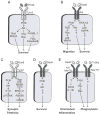TAM receptor tyrosine kinases: expression, disease and oncogenesis in the central nervous system
- PMID: 24184575
- PMCID: PMC4141466
- DOI: 10.1016/j.brainres.2013.10.049
TAM receptor tyrosine kinases: expression, disease and oncogenesis in the central nervous system
Abstract
Receptor tyrosine kinases (RTKs) are cell surface proteins that tightly regulate a variety of downstream intra-cellular processes; ligand-receptor interactions result in cascades of signaling events leading to growth, proliferation, differentiation and migration. There are 58 described RTKs, which are further categorized into 20 different RTK families. When dysregulated or overexpressed, these RTKs are implicated in disordered growth, development, and oncogenesis. The TAM family of RTKs, consisting of Tyro3, Axl, and MerTK, is prominently expressed during the development and function of the central nervous system (CNS). Aberrant expression and dysregulated activation of TAM family members has been demonstrated in a variety of CNS-related disorders and diseases, including the most common but least treatable brain cancer in children and adults: glioblastoma multiforme.
Keywords: Alzheimer's disease; Cell signaling; Developmental neurology; Glioblastoma; Multiple sclerosis.
© 2013 Published by Elsevier B.V.
Figures


References
-
- Allen MP, et al. Growth arrest-specific gene 6 (Gas6)/adhesion related kinase (Ark) signaling promotes gonadotropin-releasing hormone neuronal survival via extracellular signal-regulated kinase (ERK) and Akt. Mol Endocrinol. 1999;13:191–201. - PubMed
-
- Bellosta P, et al. Signaling through the ARK tyrosine kinase receptor protects from apoptosis in the absence of growth stimulation. Oncogene. 1997;15:2387–2397. - PubMed
Publication types
MeSH terms
Substances
Grants and funding
LinkOut - more resources
Full Text Sources
Other Literature Sources
Research Materials
Miscellaneous

